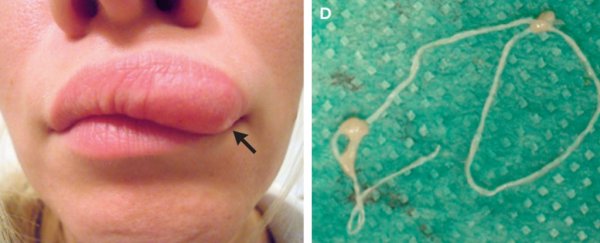We've all heard the urban legend about the woman with the spiders living in her face, but we've always been able to comfort ourselves with its falseness. Now we've had a very unwelcome reminder face creepy-crawlies are indeed possible, thanks to the case of a woman in Russia.
The first hint that something was awry was a small lump under her left eye. The 32-year-old took a photo to document it and carried on.
But five days later it had done something face lumps don't usually do. It had moved to just above her left eyelid - carrying with it an itching and burning sensation.
A further 10 days later, it had moved again, this time puffing up the left side of her upper lip. So she finally went to the doctor to find out what was causing it.
There are a number of medical conditions that can cause bumps and lumps in the skin of your face, but this turned out to be none of those.
"A physical examination showed a superficial moving oblong nodule at the left upper eyelid," her doctor wrote in a case report. "A parasite was fixed with forceps and removed surgically."
 (Kartashev and Simon/New England Journal of Medicine)
(Kartashev and Simon/New England Journal of Medicine)
It turns out the woman had been infected by a parasitic nematode called Dirofilaria repens, and although it makes one's skin crawl (literally), it's actually not so bad, as far as human parasite infections go.
That's because humans aren't its preferred host - it usually lives in carnivores, such as cats, dogs, wolves, coyotes, foxes and sea lions. It's transmitted via mosquitoes, which is how it gets into humans, but human infection is accidental.
The worm can't actually reach maturity inside the human body, and therefore can't reproduce. But it can still crawl about under there, with many patients reporting a creeping sensation under their skin.
Cases are pretty rare, too, but weirdly enough they're on the rise. They also occur around the world - and in Russia and Belarus, 1,272 cases were identified between 1997 and 2013, most of which were not reported in medical journals.
In the case of this particular patient, she had travelled to a rural area outside of Moscow where, her doctor noted, she reported having been frequently bitten by mosquitoes. So perhaps all you need is a decent mozzie repellent.
And it's pretty easy to cure, too. Since it can't lay eggs, all you have to do is take out the worm, and that's it, you're done.
On reflection, it seems much less horrifying than a cockroach in the ear.
"After removal of the worm," the doctors wrote, "the patient had a full recovery."
The case report was published in the New England Journal of Medicine.
